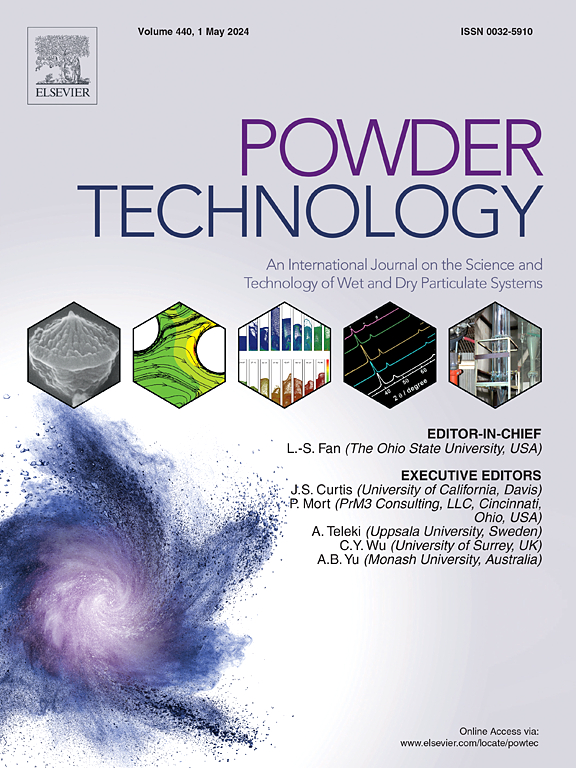Study of the effect of interaction coefficients on dynamic stacking behaviour under various particle shapes
IF 4.5
2区 工程技术
Q2 ENGINEERING, CHEMICAL
引用次数: 0
Abstract
The angle of repose (AoR) is a characteristic parameter of powder and granular materials and is the most intuitive manifestation of particle stacking behaviour. When the particle morphology and interaction coefficient change, the particle stacking morphology and AoR also change. In this paper, to obtain the factors affecting the dynamic stacking behaviour of gangue particles, relying on the injection AoR measuring device and the dynamic stacking simulation model, we designed the orthogonal simulation experiments with the restitution coefficient of particle-particle (PPRC), the static friction coefficient of particle-particle (PPSF), the rolling friction of particle-particle (PPRF), the restitution coefficient of particle-wall (PWRC), the static friction coefficient of particle-wall(PWSF), and the rolling friction coefficient of particle-wall (PWRF) as the influencing factors. Taking the AoR as the evaluation index, we simulated 125 sets of dynamic stacking simulation experiments with different particle morphologies. We obtained the interaction coefficient schemes matching the experiments and the influence laws of the six interaction coefficients on the evaluation index. Among them, the static friction coefficient has the most significant influence. The prediction of the stacking shape formula for rectangular particles was verified, and the error between the prediction result and the actual stacking result was within 15 %, which indicates that other combinations of interaction coefficients can be based on the formula for stacking shape prediction. The model and the prediction method guide the study of the stacking morphology and kinematic behaviour of other particles.

不同粒子形状下相互作用系数对动态堆积行为影响的研究
休止角(AoR)是粉末和颗粒材料的特征参数,是颗粒堆积行为最直观的表现。当粒子形态和相互作用系数发生变化时,粒子的堆积形态和AoR也会发生变化。本文为获得影响脉石颗粒动态堆积行为的因素,依托注射AoR测量装置和动态堆积模拟模型,设计了颗粒-颗粒恢复系数(PPRC)、颗粒-颗粒静摩擦系数(PPSF)、颗粒-颗粒滚动摩擦系数(PPRF)、颗粒-颗粒壁恢复系数(PWRC)、以颗粒壁面静摩擦系数(PWSF)和颗粒壁面滚动摩擦系数(PWRF)为影响因素。以AoR为评价指标,模拟了125组不同颗粒形态的动态叠加模拟实验。得到了与实验相匹配的相互作用系数方案,以及六个相互作用系数对评价指标的影响规律。其中,静摩擦系数的影响最为显著。对矩形粒子堆积形状公式的预测结果进行了验证,预测结果与实际堆积结果的误差在15%以内,表明可以基于该公式进行其他相互作用系数组合的堆积形状预测。该模型和预测方法对其他粒子的堆积形态和运动行为的研究具有指导意义。
本文章由计算机程序翻译,如有差异,请以英文原文为准。
求助全文
约1分钟内获得全文
求助全文
来源期刊

Powder Technology
工程技术-工程:化工
CiteScore
9.90
自引率
15.40%
发文量
1047
审稿时长
46 days
期刊介绍:
Powder Technology is an International Journal on the Science and Technology of Wet and Dry Particulate Systems. Powder Technology publishes papers on all aspects of the formation of particles and their characterisation and on the study of systems containing particulate solids. No limitation is imposed on the size of the particles, which may range from nanometre scale, as in pigments or aerosols, to that of mined or quarried materials. The following list of topics is not intended to be comprehensive, but rather to indicate typical subjects which fall within the scope of the journal's interests:
Formation and synthesis of particles by precipitation and other methods.
Modification of particles by agglomeration, coating, comminution and attrition.
Characterisation of the size, shape, surface area, pore structure and strength of particles and agglomerates (including the origins and effects of inter particle forces).
Packing, failure, flow and permeability of assemblies of particles.
Particle-particle interactions and suspension rheology.
Handling and processing operations such as slurry flow, fluidization, pneumatic conveying.
Interactions between particles and their environment, including delivery of particulate products to the body.
Applications of particle technology in production of pharmaceuticals, chemicals, foods, pigments, structural, and functional materials and in environmental and energy related matters.
For materials-oriented contributions we are looking for articles revealing the effect of particle/powder characteristics (size, morphology and composition, in that order) on material performance or functionality and, ideally, comparison to any industrial standard.
 求助内容:
求助内容: 应助结果提醒方式:
应助结果提醒方式:


